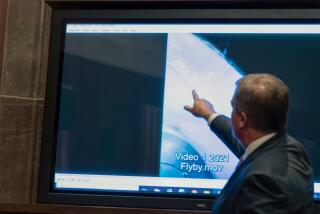Spacecraft to View Hidden Light of the Universe : Exploration: Telescopes will detect extreme ultraviolet waves that are absorbed by Earth’s atmosphere. Scientists hope to find new stars.
- Share via
A U.S. explorer spacecraft, scheduled for launch from Cape Canaveral Air Force Station on Saturday, is expected to open a window to the universe along the least explored section of the electromagnetic spectrum.
More than 40 years have passed since scientists first moved beyond optical light to map the heavens using different kinds of “seeing”--the sensing of photons at wavelengths not visible to the human eye. Photons are particles of electromagnetic radiation. People can see only the light emitted by photons within one narrow range of wavelengths.
Detecting photons at radio wavelengths, astronomers found cool gas clouds that may form new stars. Analyzing photons that travel in the infrared, they discovered young stars too cool to emit light that our eyes can see and hot stars whose visible light had been absorbed by dust in space. X-rays revealed faint companion stars to already known stars; no one had known such star pairs existed.
Now, after 20 years labor by two UC Berkeley astronomers, the Extreme Ultraviolet Explorer is on the verge of filling the last major gap in such surveys of the universe. EUVE, as the craft is known, is designed to detect sources of waves that are longer than X-rays and shorter than ordinary ultraviolet light. (Visible light travels in longer waves than ordinary ultraviolet light).
From its orbit 328 miles above the Earth, EUVE is expected to discover previously unknown hot white dwarf stars, provide more information about coronas of stars and plumb the mysteries of the radiation emitted by Io, a moon of Jupiter. There may be surprises, too, during the two-year, $200-million mission.
“It’s like Lewis and Clark,” said Stuart Bowyer, director of Berkeley’s Center for Extreme Ultraviolet Astrophysics. “We know there will be mountains out there, and rivers. We’re going to find out how big they are and where they are. And we might find some wild animals.”
Knowing the contents of the universe can help scientists in their quest to understand how it started, how it evolved, if it contains life elsewhere and its eventual fate.
“Without the extreme ultraviolet, we would have only part of the picture,” said Yoji Kondo, EUVE project scientist for the National Aeronautics and Space Administration, which is financing the mission.
The only possible way to receive extreme ultraviolet waves is to send telescopes into space. The Earth’s atmosphere absorbs all the rays in that wavelength approaching this planet.
For years, many scientists were skeptical that the delicate waves could be detected even from near-Earth orbit. They thought the rays would be absorbed by the interstellar medium--gas and dust between the planets, stars and asteroids. Indeed, that band on the electromagnetic spectrum was known as the “unobservable ultraviolet.”
So when Bowyer first started trumpeting that “this is a field ripe for picking” in the late 1960s, his notion was generally met with derision. The conventional wisdom was, “You cannot see at this wavelength except the sun. That’s it. Goodby,” he said.
Still, he managed to get a telescope aboard the Apollo-Soyuz mission in 1975. It picked up four other sources of extreme ultraviolet radiation.
It turned out that the interstellar medium contained clumps and gaps, and if the telescope was trained through the gaps, the data seeped through. “I compare it to won-ton soup,” Bowyer said. Earth “happens to be in a small won-ton that kind of makes things foggy for about 10 light years. Outside of that, (there is) soup.”
While conceding that EUVE will indeed see past the solar system, some other astrophysicists still wonder whether the craft will be able to discern much outside the Milky Way.
Bowyer insists that it will. The EUVE range should extend, he said, “in a few directions out of the galaxies and to other galaxies and in fact to distances so far that they are in the realm of the quasars and the origin of galaxies, 5 billion light years away.”
After launch on a Delta II rocket and 45 days of equipment checkout, EUVE will check the universe along the entire extreme ultraviolet band for six months. Three scanning telescopes, each detecting a different wavelength, will map the sky, while a fourth tries to look out toward the farthest distances.
Once the scan is complete, scientists from around the world will use that fourth telescope for in-depth studies of particular emitters. It is equipped with a spectrometer that can determine chemical makeup.
(Southland Edition) The EUVE Launch
Background: The Extreme Ultraviolet Explorer, known by the acronym EUVE, is scheduled for launch Saturday from Cape Canaveral in Florida.
Purpose: The two-year, $200-million mission is designed to examine stars using extreme ultraviolet light, one of the least-studied portions of the electromagnetic spectrum.
What It Is: Electromagnetic radiation--photons--travels in waves of various lengths. The shorter the length, the higher the energy of the rays. Only certain bands, such as visible light and radio waves, completely penetrate Earth’s atmosphere. At the high-energy range of the spectrum are gamma rays, followed by X-rays, extreme ultraviolet, ultraviolet, visible light, infrared and radio.






